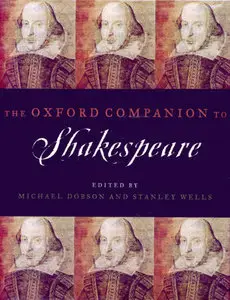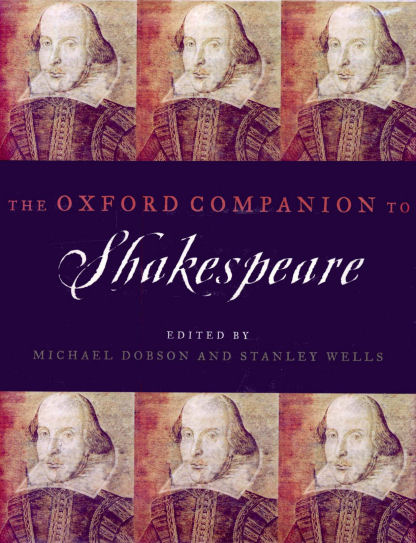Michael Dobson & Stanley Wells (eds), "The Oxford Companion To Shakespeare"
Oxford University Press | ISBN 0198117353 | 2001 | 576 pages | siPDF | 26.8 MB
Oxford University Press | ISBN 0198117353 | 2001 | 576 pages | siPDF | 26.8 MB
From the conjectured identity of the Dark Lady of the Sonnets to misprints in the First Folio, from Shakespeare's favorite figures of speech to the staging of Othello in South Africa, The Oxford Companion to Shakespeare offers the most comprehensive coverage available on all aspects of Shakespeare's life and works.
- Illustrated with more than 100 photographs and boasting contributions from a team of internationally renowned scholars (including such noted Shakespeare authorities as Helen Vendler, Park Honan, and Jonathan Bate), the Companion has more than 3,000 entries that offer succinct, stimulating, and authoritative commentary on Shakespeare's life and times, his plays and poems, and their interpretation around the world over the last four centuries.
- All Shakespeare's plays—from As You Like It and All's Well that Ends Well to King Lear and Hamlet—are covered in major articles.
- There are concise descriptions of allusions in Shakespeare (Ajax, Agamemnon), well-known critics (Samuel Johnson, John Dryden), great Shakespearian actors (Richard Burbage, Lawrence Olivier, Kenneth Branagh), characters in the plays (Mercutio, Ophelia), figures of speech (metaphor, metonymy, oxymoron), and much more.
- Longer articles explore topics such as Shakespeare's birthplace, censorship, the Chamberlain's Men, film, and Shakespeare's reception in such countries as China, Italy, and the United States.
From Library Journal
Companions to Shakespeare are ubiquitous, coming bound with various editions of the plays, in A-to-Z companions, and in many other manifestations. The Oxford Companion enters into this crowded field with both rigor and authority. Following in the very large footsteps of The Oxford Shakespeare (2001), this companion has the same formatting (from text lines to play names and character spellings) and is of the same stellar quality. Comprising more than 3000 entries, it covers topics such as Shakespeare's biography, legend, works, literary features and terms, individuals (both real and fictional), and a host of topics such as Elizabethan and Jacobean literature and theater, which help put in context both the times and the works.
Of particular note are the entries on each play, which include scene-by-scene explanations as well as examinations of the play's particular artistic features, critical history, and stage and screen history, and a listing of recent editions and selected criticism. There is enough in each play summary to aid students from middle school to college. The attention paid to the poetic work of Shakespeare is also noteworthy. From "Venus and Adonis," "The Rape of Lucrece," and "Lover's Complaint" right through to a general section on the sonnets, the treatment is as in-depth and as helpful as that of the plays. Enlivened by photos and illustrations and an excellent map keyed to the history plays, this work is highly recommend for all libraries.
From Booklist
It is difficult to think of a topic that is not touched upon in this new handbook designed "to inform readers about Shakespeare's works, times, lives, and afterlives." As one might expect, there are entries for the plays and sonnets, sources and themes, and significant people and places in Shakespeare's life, as well as for aspects of interpretation and performance over the years. What one might not expect are entries that throw light onto obscure details (Mulberry tree; Performance times, lengths; Shakespeare Society of China; Trapdoors), as well as those for topics that at first glance seem only remotely relevant (Ceramics; Melville, Herman; Romania; Tobacco).
Among the more than 3,000 signed entries are brief identifications of every character and in-depth treatments of each play. Articles on plays are several pages long and provide background information on text and sources, followed by plot summaries and discussions of artistic features, stage history, and screen presentations. Other entries cover biographical details, literary and cultural context, publishing history, literary terms, criticism, and scholarship. Particular emphasis is placed on theatrical history, from the productions of Shakespeare's time to Royal Shakespeare Company, Silent films, and Television. Notable players, from Thomas Betterton (1635-1710), "the greatest actor of the Restoration period," to Kenneth Branagh, Judi Dench, and Ian McKellen are included. Also represented are countries and regions, among them Arab world, Japan, and Scandinavia. Most entries are quite short, but broader topics, such as Music, Nineteenth-century Shakespearian production, and Trade, travel, and colonialism, are given at least a page. Many entries conclude with a brief list of resources. A detailed "Thematic Listing of Entries" helps compensate for the paucity of cross-references. Among other supplemental aids are a chronology and a bibliographic essay noting introductory studies and standard reference works.
Coeditor Wells also edited (with Gary Taylor) the modern-spelling edition of Oxford's Complete Works (1986) upon which the companion is based. In their introduction, Wells and Dobson admit to "some small bias" toward theaters in London and Stratford-upon-Avon. North American readers may take issue with the short shrift given to the Stratford Festival in Stratford, Ontario, and its "Hollywood-like emphasis on costumes, props, and gimmicks." The entry United States of America talks about the Classics Illustrated comic-book versions of the plays and notes Shakespearian elements in television series such as Gilligan's Island, but does not mention the Chicago Shakespeare Theater, the Oregon Shakespeare Festival, or any of the many other serious American enterprises devoted to Shakespeare's work. Some entries, such as Cultural materialism, will baffle nonspecialists. A few entry headings are arcane (movies are discussed under Shakespeare on sound film), and the lack of indexing means that information can be hard to retrieve. But its embrace of all things Shakespearian makes this volume a necessity for academic and public libraries. High-school libraries should also consider it, although high-schoolers may find Scribner's Shakespeare's World and Work [RBB S 1 01] more accessible.
Tags: History, Literature
Marc Norman & Tom Stoppard...re in Love: A Screenplay"



